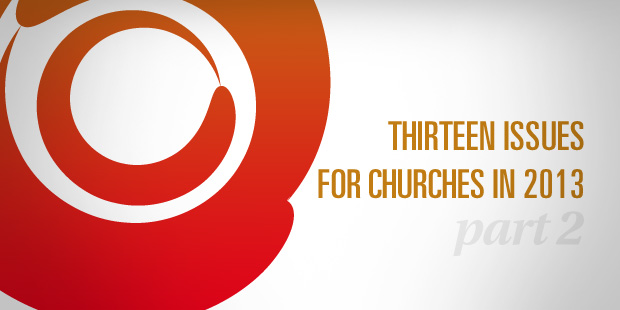
Thirteen Issues for Churches in 2013, Part Two
In a previous post, I noted six key issues facing many American congregations. I will discuss seven more issues in this article, and thus provide 13 issues for 2013. As a reminder, these 13 items are not as much prognostications as they are current trends that are accelerating.
- Innovative use of space. I recently drove onto a church property located on approximately three to four acres. My consultant training told me that 300 to 500 people could worship on that site. The Millennial pastor who was riding with me said that the site could easily accommodate 2,000 in attendance. The younger pastor did not see limitations of times or days of worship. Indeed that generation will cause us to look anew at church space limitations.
- Heightened conflict. The Millennial generation will not accept church-as-usual. They are shaking the status quo in many churches. They are not seeking to be adversarial; they are simply asking tough questions that those of us in older generations were reticent to address. Anecdotally the greatest resistance to change is occurring in the Builder generation and the older Boomer generation (roughly including those born before 1955).
- Adversarial government. More public schools and other public facilities will be less accepting of churches meeting in their facilities. Some other local governments are resisting approval of non-tax paying congregations expanding their facilities. New churches and existing churches that are expanding their venues will be forced to become more creative as they look for new locations.
- Community focus. One of the great benefits the Millennial generation brings to our churches is their focus on the community in which the church is located. They are not content simply to offer ministries to those who come to the church facilities; they are going into the community to serve the merchants and residents who work and live there.
- Cultural discomfort. Many of the issues noted thus far point to growing levels of discomfort for the congregations in the culture they seek to minister and serve. For all of the twentieth century and even the early years of the twenty-first century, it was culturally acceptable, even expected, to be a part of a local congregation. Those expectations are all but gone. There is a growing and distinct divide between the values of the culture and the Christian values most churches hold.
- Organizational distrust. There is a pervasive and growing distrust of institutions in general. Those institutions are found in both government and business, but religious institutions are not exempt from this lack of trust. That diminishing confidence exudes from those both in churches and those who do not attend churches.
- Reductions in church staff. I am watching this development carefully. Two different forces are at work. First, in many congregations there is a greater emphasis on laypersons handling roles once led by paid staff. Second, the tough economic climate and declining church attendance are naturally affecting church budgets. Congregations are reticent to fire staff, but more and more are not filling vacant positions.
What is your reaction to these issues? What trends would you add to this list?
Read Part One here.
Read more from Thom here.

Tags: Leadership Engine, Planning, Thom Rainer













